Video Vortex: Alternative platforms and software
This session is the most concrete session of today. The focus is on practical views on online video from the perspective of speakers’ practices. How do video artist, activists, programmers and curators deal with copyright issues, publishing and distributing videos? Main issue addressed in this session relates to the most ideal alternative platforms that can be created for online video. What are the differences and similarities compared to YouTube? How do these alternatives deal with open source software and p2p processes? And how do they deal with user agreemenst and proprietary software? Why not YouTube?
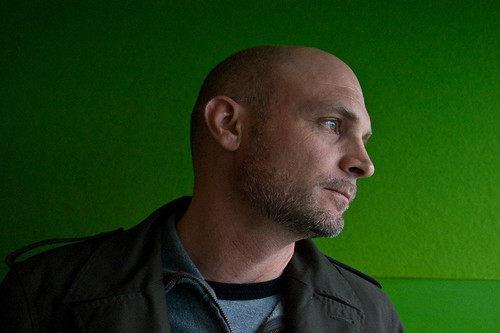
Moderated by Seth Keen, the speakers in this session will investigate developments in the field of open source software in creating alternatives to proprietary software like Windows Media Player. Through investigating p2p alternatives and open licenses, both users and programmers aim to create a truly distributed network, in which content can freely float around without having to use centralized servers and sign strings of user agreements. Moderator Seth Keen and Geert Lovink developed the concept of the Video Vortex conference together.
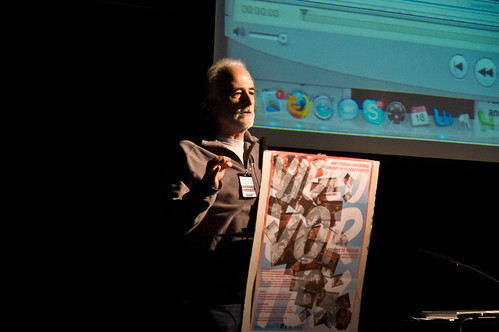
All photo’s by Anne Helmond
Michael Smolens – Cross-cultural communication through real-time translation
Last minute addition to this session and first up is Michael Smolens. His main interest lies in cultural needs around the world and how digital technology can provide new means for cross-cultural communication. A documentary like 9/11 Truth shows the impact one documentary can have on public opinion. It is not hard to imagine there are numerous movies around the world with similar impact but are not accessible due to language issues. His project aims to use open source-wikipedia like software to make every movie available in all languages, in all kinds of formats. His project dotSUB does this by making use of RSS in 24 languages. It is basically a real-time translation tool on the Web. This project shows a sensitivity for cultural significance. Language is impediment in understanding other cultures but can also be a barrier that creates misunderstandings.
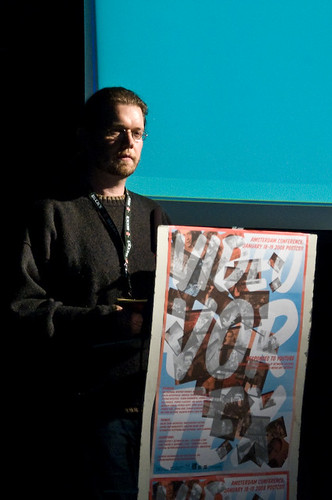
Matthew Mitchem – Video Social: Amateur video and virtuosity in collaboratively produced media
Matthew Mitchem shows a political/activistic clip “A Cold Day in DC” that reflects on the second inauguration of the Bush administration. This documentary was his first involvement in making videos. With a background in philosophy and an interest in politics, he positions himself as a political video maker.
What are YouTube alternatives? Matthew explores this question by looking at the first answer that comes to his mind: television. In his presentation Matthew argues lines between television and online video are blurring in two ways. First of all, the boundaries between old and new media are blurring because YouTube is becoming a popular source for mainstream media to reflect upon. One consequence is that YouTube is getting more political importance. The video “Vote Different” shows a 1984ish movie based on a 90ties Apple commercial. The maker was slightly related to the Barack Obama campaign and was fired after this video got enormous airtime. During the Hurricane Katrina, CNN advised people to stay in doors, but requested viewers if they did get out anyway, to take their video camera with them. Eye reports or citizen journalism via videos were a substantial part of the CNN reports on Katrina.
For this conference Matthew decided to become a YouTube addict and got involved with commenting and replying. He shows an online video concerning Hillary Clinton and repetition. The video “Hillary Clinton: Favorite Word” shows a very narcissistic Hillary Clinton (lots of “i’s” and “me’s”). Right after the interview this video was online. Most hits for that video were on the next day. Since there were a lot of videos responding to that interview it was difficult to get many hits. If you want to be viewed tag well. The point he makes is that YouTube has become part of the political project, not separated form it.
Secondly, he argues television is not at all that distinct from YouTube because there are numerous sites that provide channels or topic specific online videos, including Godtube, Gospeltube, Ning, Channelme.tv. They are basically a ‘filter’ for online videos. In the example of Ning, you can create your own social networking site (under a license agreement) Also, Channelme.tv, is quite big and allows for alternative use. From this television perspective we don’t need to construct more alternative to YouTube because public access television is already available through these filter-like sites. These sites are often built on top of mayor sites like YouTube.
His project Multitude.tv is one such examples that provide means for Web users to create and share their filtered channels. Multitude.tv is recently redesigned and now makes use of a WordPress-like cms called Joomla! Joomla! works on database management and FTP. The benefit is that you can use your own user agreements and it has the-same functionality as YouTube, with lots of open source plugins. You can basically create your own YouTube. Unfortunately he didn’t elaborate on Multitude.tv much. Questions from the audience were mostly about Multitude.tv which provided him with the possibility to elaborate on this project. Multitude.tv is a also a filter-like project, like for instance Godtube and has multiple channels. Since they also make use of YouTube content and therefore also transferring copyright with the content they copy to their site, there was also a question relating to this. How do they deal with that? The answer was simply put: they don’t. They don’t have lawyers, mostly because they are not as financially attractive as YouTube. Furthermore, when they receive complains about a specific movie being copyrighted they remove it. Another interesting question was about the collaborate aspect of the project. When Matthew and his colleagues were filming “Cold Day in DC” they saw that lot of people were filming. Although they were only ones making feature documentary about second inauguration, there were a lot of citizen journalists. Multitude.tv is also a platform to create collaborative group where these videos can be collected and shared.
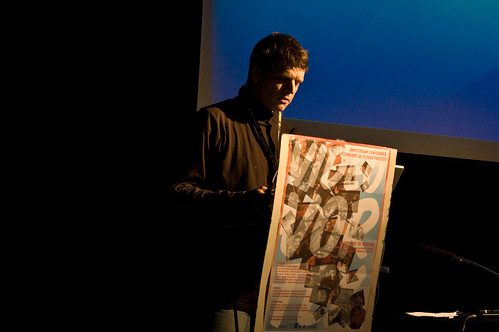
Valentin Spirik – Open source ways of producing, distributing and promoting online video
Valentin Spirik is part of P2pFoundation.net. He approaches alternative ways of producing, distributing and promoting online video by looking at free and open-source software like 3D modeling/animation application Blender and open-media platforms and tools. Valentin is film maker and into collecting and filtering open source video tools. In the last couple of years his focus moved to online distribution. He discusses open source software by talking about the ways he as film maker promotes, uploads and distributes own videos. Providing a kind of HowTo for finding ways into existing alternatives to YouTube. With this he hopes people to be inspired and find alternatives to YouTube. His method of working with online video is illustrated with examples such as “Indiworks Channel” which involved remixing video, 3D animation and vlogging.
His first recommendation is to have a blog. Valentin uses uses WordPress, but it can also be Blogger or another blog software platform. The downside of WordPress is that it cant embed Blip.tv videos because of some security issue in the code. Only YouTube and Google Video can be embedded which is not a good thing. Valentine prefers Blip.tv over YouTube because it supports creative commons license which YouTube does not. Blip.tv also support more file types next to Flash which is the only type YouTube supports. Before using Blip.tv he used Archive.org. Archive.org is an important site because it is a free and big digital library. Archive.org doesn’t charge for storing videos. They only make you agree that people are able to download your video. In the open-source pond his video’s can still be found such as his first (half) feature film “Vincent“. Valentin makes an interesting remark about online video distribution. The notion that everything is getting faster and smaller and easier is only half the story. The other side of the story is slow distribution via the internet. In traditional cinema movies go away can not be seen again.Archive.org for instance lets you see movies and files over and over again, when you want to; it allows you to distribute your movie into eternity. And for free. This argument taps into the argument made by Florian Shneider that the Web is not about real-time but rather about “anytime wherever”.
Nicely complementing the previous speaker who talked about ‘filters’ for online videos, Valentin discusses a possibility for creating alternatives to YouTube by creating channels. On Videobomb.com you can bookmark favorite videos and make playlists. After making a playlist, you can create a feed and it becomes basically a channel. In aggregators such as Getmiro.com you can can submit your channel. Before this possibility of creating channels existed he used Ourmedia.org. Ourmedia.org is very simply put a community built on top of Archive.org. This was actually an ‘alternative to YouTube’ before YouTube existed. These alternatives are both mainly about link copying. In linking it to your own site, you create your own video channel – a very strong and easy alternative to YouTube. This is great for independent film makers because you can create your own channel. According to Valentin there is no excuse left to not post your stuff online. On the p2pfoundation.net wiki on the Audiovisual Guide page, there are all kinds of documentation on ways how to get your stuff online.
By showing trailer mash-up between terminator and E.T. “The Real Digital Revolution” Valentin shares his thoughts on copyright issues. The mash-up is a commentary of what is going on online. Concerning copyright, this trailer has some discussions around it. The power of video is that you can show it. Strange is that we are allowed to quote text, but not video. While the thing is with videos that you have to show them, not talk about them. To not be able to show videos is absurd.
The last open source solution Valentin addresses is Blender, which is a 3D application. You can even change the code if you want. While the commercial version of software like this costs between 2000 and 5000 dollars and the code cannot be changed. Blender is free and works. To demonstrate Blender Valentin ends with a preview of a Blender-made movie that is not yet finished called “Vivaldi-rock”.

Philine von Guretzky – Bridging the gap: Redefining the platforms for moving image
Berlin based Philine works with an organization called Tank.tv. Online gallery Tank.tv is dedicated to showing video artist in different contexts. It is an alternative to YouTube specifically for video artist. The artworld is at a change this moment, also in video art. Recently video art is been made more available, blurring the line between traditional art categories. Tank.tv is experimental and acts as an online gallery especially for independent and new artists. Since 2003 they have been online and mayor changes are happening now. The number of viewers increase, content increases, and ways of working change.
Artists and traditional galleries initially were afraid for publishing online because it would devalue the work and make it easy to copy. Tank.tv is now more accepted within institutions and they curate shows a couple of times per year in collaboration with other institutions. The videos shown online are reduced to three minute-videos and in museums (such as Tate Modern), on a big screen, full videos are shown. Together with Park.nl Tank.tv has also curated for a whole year an Urbanscreen in the south of Amsterdam. No commercials, just video art.
In what way is Tank.tv really different than YouTube? First of all videos are not embeddable on sites. They have the philosophy that it is more respectful to the piece and more about the piece itself when it is shown on this curatorial site. Some artist don’t want to be shown next to a funny kitten movie and Thank.tv provides a platform for such artists. The strength of Tank.tv lies with the group as such. It is a small curated amount. Copyright issues are not a problem for this alternative and dealt with rather easily; the artist signs that its not Tanks.tv’s problem if it turns out to be a video that is copyrighted by someone else.
Ian White wanted to create a list of lists of videos. They are an online gallery that only show what is admitted. Therefore you are invited to submit to the list of lists. Best is on minidvd for submission.
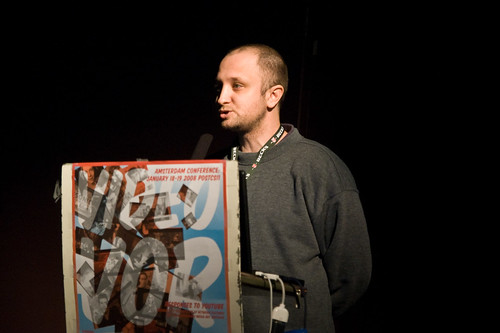
Jay Dedman – Show-in-a-box, WordPress video distribution system
Presentation of videos is very important for online works and media activists. Open source and sane copyrights are also important. Jay Dedman and college Ryanne Hodson have developed Show-in-a-box, a tool that makes WordPress better suitable for WordPress. With the goal of creating the ultimate videoblogging platform by providing WordPress installs, this alternative builds on YouTube and WordPress.
In asking for a revolution in online video, he claims that it already happened. YouTube is a revolution. However, “YouTube makes my work look bad”, that is the main problem. Although this argument for an alternative to YouTube sounds similar to the argument made by Philine, Jay does not argue for presenting the pieces he makes as stand alone videos. Jay considers himself a storyteller and requires good quality for his videos. Showinabox.tv. mixes your WordPress site with good video displaying. Most storytellers are not familiar with php, html etc. so they really need tools otherwise they will get left out. Voices need to be heard. What he considers problems concerning online video can be solved by adjusting WordPress. A blog works well for text, but not really for video.
Jay started to make a list with critical thinkers, film makers to see how they deal with distributing and presenting videos and the problems they come accross. Momentshowing.net was the blog he started with. The blog format looks like a diary and it is almost impossible to find old videos except on date search or clicking through the archive. As more speakers have addressed in this conference, it is important for video artists videos can be found “anytime wherever”. Because video archiving and searching does not work good, the blog does not serve this need.
As a second example he shows Politicalvideo.org, a political video scraper that allows you to mix these videos. The blog does not allow video to easily work with it: too much text-based. For visual creators, a blog often does not suffice and support creativity. Also when vlogging is about raising money for visual projects, donating via paypal for instance, again a blog is not ideal. For this to work they even needed to hack WordPress.
Another project deals with getting 8mm movies online, still difficult to find a format that handles these files. The Show-in-a-box project is about volunteers that create open source plugins in order to create a good alternative YouTube that does not scramble with your quality. A first pilot is Ryanishungry.com. It is a blog, but offers different video formats and shares (called VPIP, video paste in place). Point to make is that video artists need to get involved in the creation of new media tools. Pledge drive features plugin for WordPress is about also financially helping each-other out (because youTube isn’t gonna!).
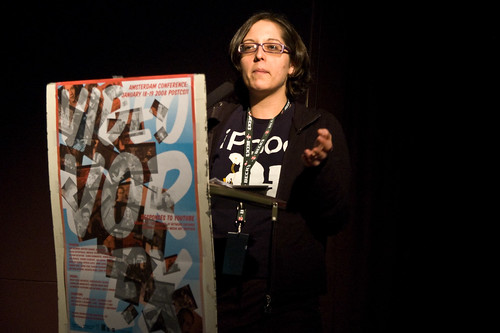
Tatiana De La O – Independent media
Tatiana approaches alternatives to YouTube yet from another way. Not addressing YouTube alone, rather the Web 2.0 revolution as a whole. Tatiana is part of Indymedia, however she is not representing them. It is the first open independent open source publishing site and she wants to talk about how they are different to the 2.0 revolution. Independent media sites are looking at web 2.0 with two different attitudes. On the one side they want to learn to network the different producers better and spread good material better. On the other, narcissism and individualism of the blogosphere is seen as counter productive by most of the activist programmers.
Sites like Indymedia and Archive.org are about seriousness of the information that is on display. They are often event-driven and reactive to reality. Independent media are mostly run by volunteers and reactionary. The problem is that they are sometimes anxious that the police will come and shut their servers down and they do not have that expensive professional software. This does not always makes them look as professional as commercial Web 2.0 sites. It is however not so that Indymedia is unstable and Flickr or YouTube is stable. The police can also remove your video from YouTube.
2.0 is about friends of your contact list. The advantage of 2.0 sites is that you can control the feedback, It is gentle, more stable, more fun. In many independent media sites one cannot do this. She makes a point about content politics, taking democracy to media production. Her main argument against 2.0 is that it takes down democracy. People that like kittens and fun are free on YouTube. People that are serious or political not always. Who is adjusting content? What is democracy? Something unequal. Just like 2.0? A pervert thing in Flickr is that they have sneaky ways of hiding content by not showing tags in searches. If your pictures are dirty they get tagged nipsa which means it can not be found in a search. If you admit to Flickr your picture is nipsa yourself, only that picture is removed from the search results. When Flickr find out themselves, then the whole account is removed. This is about diverting information (agency and control). Old-school politics are transferred onto media sites. Indymedia did Web 2.0ish things as well, but called it open-publishing.
Tatiana ends her talk with 2.0 lessons. Indymedia were fighting for revolution and people went to 2.0. Their first reaction was “why! have you seen the licensing!”. The first lesson is that they learned not to be jealous. People use the tools they can use and they will use it (YouTube, Flickr). Why fight it? Secondly they think more about syndicating content via YouTube. Try to talk more with users what features they like (not too much though). About marketing and means, they want to make revolution irresistible! if content is elaborated, it gets more attention. Still, it has to be quick. Lots of open source and free software is emerging. We are now preparing tools for this new revolution. We show what we are doing. They are not reactive to market (2.0 buzz), but to what people are doing.